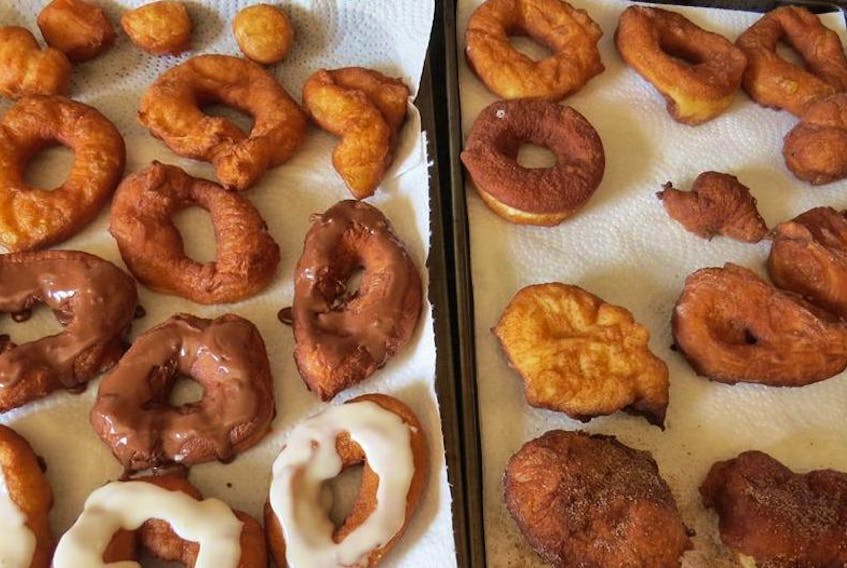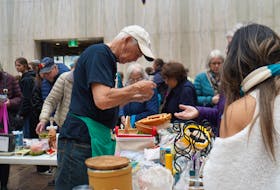No matter what you do, there is always a lesson. Often the lessons are more powerful when things don’t turn out well.
That was the case when I decided to further my experience with yeast breads by making doughnuts. I’d seen pictures online of an array of doughnuts that a friend and her husband had made; they looked professionally done and tempting. I wondered if I could do as well.
The usual way of making yeast bread dough is called the straight dough method. For this method, the yeast is proofed, meaning that it is sprinkled into warm water to which a small amount of sugar has been added. It’s set aside in a warm place until the yeast dissolves and the mixture puffs up. At that point, the liquids (milk, water, eggs, melted fat) and soluble ingredients (sugar, salt) are combined and the yeast mixture is added, along with about one-third of the flour. It’s beaten vigorously with a wooden spoon or an electric mixer for three or four minutes.
Flour is added gradually until it is impossible to stir the mixture easily, and the remaining flour is kneaded into the dough. It then is allowed to rise until double in volume, punched down, shaped and allowed to rise again before baking.
The doughnut recipe that I chose used the sponge method instead. For the sponge method, yeast is proofed and mixed with 250 mL (1 cup) of liquid from the recipe. Then a portion of the flour is stirred in to make a lumpy mixture – the sponge – which is left to rise. After the sponge has risen and is transformed into a stretchy mass full of large bubbles, the remaining liquid ingredients are stirred in, and the rest of the dry ingredients beaten and then kneaded in, as with other breads.
As I have done with other bread recipes, I used the dough hook attachment on my stand mixer to knead the dough. It was soft and sticky, a rich sweet dough with added sugar, eggs and butter, and the first rising went well.
The next step was to punch it down, roll it out, and shape the doughnuts, using a doughnut cutter that I’d had in the cupboard for some time but never used. I placed the circular doughnuts and holes on floured baking sheets and covered them with damp towels for the second rise, as directed.
The doughnuts rose, but the gooey dough stuck to the damp towels. It was a mess! After I scraped, as gently as I could, the dough from the towels, about one third of them maintained their circular shapes, and the rest were misshapen blobs.
Undeterred, I proceeded to deep-fry the circles, blobs and doughnut holes. They puffed up in the hot oil, browned nicely and cooked quickly. When they’d cooled, I topped some with the maple glaze as the recipe directed, coated a few in cinnamon sugar and drizzled a little leftover chocolate icing over some. There is a picture of the distorted doughnuts on Facebook.com/IslandGusto.
Then came the follow up. There was fat splashed over the stove top and hot oil to be disposed of. The house, and my hair, smelled like a greasy spoon restaurant. The towels used to cover the rising dough were impregnated with sticky floury mess that may never wash out. I had heartburn from taste-testing too many doughnut holes.
It was then that I remembered that the previous time I’d deep-fried food, I’d decided it was the last time. I know that in many homes, deep-frying is a preferred cooking method, but it isn’t for me. It’s too messy, and I don’t love the resulting high-fat food enough for it to be worthwhile. When the restaurants re-open, I may occasionally get an order of fries or onion rings, but I’m done with deep-frying at home.
As far as the rising dough sticking to the towels, I found two trusted sources, The Joy of Cooking and Nellie Lyle Pattinson’s Canadian Cook Book, that instruct to let the shaped doughnuts rise uncovered. That’s what I’d do if working with similar sticky doughs in future.
I’ll soon decide on a bread-baking adventure for next week. There is more to be learned!
Margaret Prouse, a home economist, can be reached by email at [email protected].









